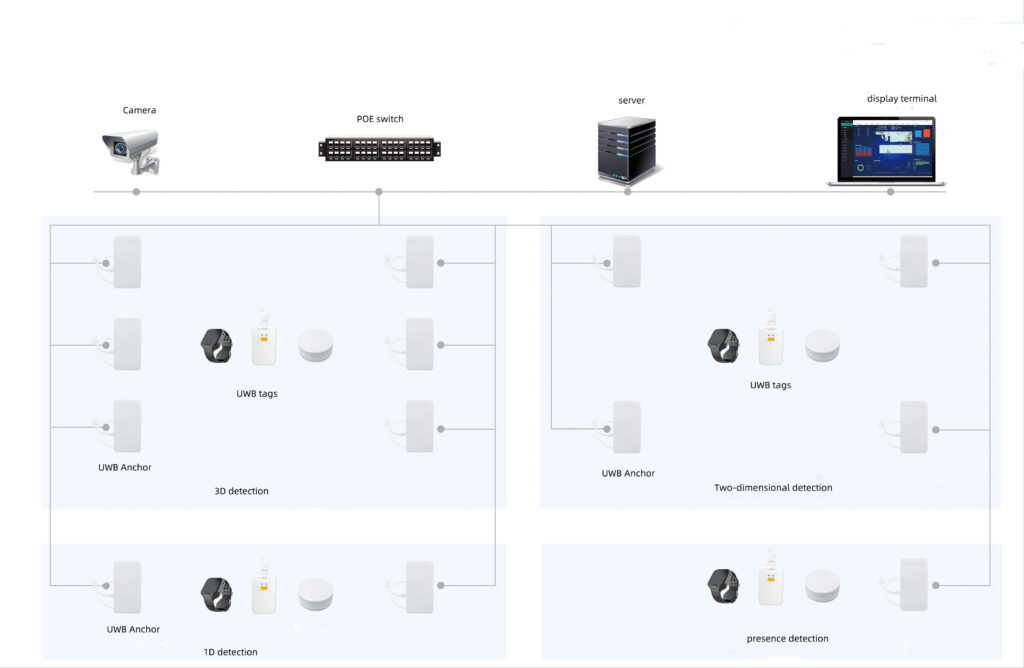Ultra-wideband is a new wireless technology that has emerged in recent years. It is very different from traditional communication technology, with high transmission rate, low transmission power and strong penetration capability.
UWB technology can achieve precise positioning of people, vehicles and assets. uwb system can realize track tracking, area alarm, camera linkage and other functions.

0-dimensional UWB indoor positioning is commonly used for presence detection. A common application scenario is to monitor whether people are in a room for a long time. 0-dimensional indoor positioning system hardware only requires a UWB base station and UWB tags to achieve. The UWB tag and the base station communicate with each other, and then through the interaction with the background, the presence monitoring and alarm functions are realized.
The principle of one-dimensional UWB positioning is the application of distance measurement. It can know the relative position of the target tag. It is suitable for multiple scenarios such as tunnels, pipelines, tube shafts and mines. The accuracy of 1D UWB positioning is about 30CM.
Two-dimensional UWB positioning needs to determine the X/Y coordinates of space. There are two cases. One is to calculate the position of the tag by the distance of the tag from the base station. The other is to determine the position of the tag in the area by using more than three base stations. It can accurately know the location and behavior trajectory of the target tag.
3D UWB positioning requires determining the XYZ 3D coordinates of the positioning device. In the base station architecture, the height difference in the Z-axis needs to be especially stretched. To ensure the accuracy in the Z-axis. In the case of ranging, three base stations are sufficient for 3D positioning. With TDOA, more than four base stations are required to complete the process. It can accurately determine the tag location, and the lag time.
UWB positioning system is roughly divided into location sensing layer, network transmission layer and positioning application layer. It mainly includes positioning engine server, intelligent terminal, POE switch, UWB base station, UWB tag, UWB module, software interface, etc.
(1) Each positioning tag sends data frames repeatedly and uninterruptedly with UWB pulses.
(2) The UWB bursts sent by the positioning tags are received by the positioning base stations.
(3) Each positioning base station measures the time when the data frame from each tag reaches the receiver antenna.
4) The positioning engine refers to the calibration data sent by the tag. It can determine the time difference between tags reaching different positioning base stations. The three-point positioning technique and optimization algorithm are used to calculate the tag position.
5) The TDOA algorithm is mostly used for positioning with multiple base stations.
(1)UWB base stations are divided into two ways: wall mounting and column mounting. The engineers recommend wall mounting, and the prepared installation kits are mainly screw kits.
(2)If the indoor environment is obstructed, it is recommended to reduce the installation spacing. Because in the case of obstruction, it will affect the reception of the signal and the transmission distance may not be as good as the ideal value.
(3)The recommended installation height of UWB base station is 2 meters.
(4)The installation of UWB base station configuration antenna. The default configuration of UWB antenna is omnidirectional antenna. The antenna should be at least greater than 15 cm from the wall, and there should be no obstruction around it.
(1)Asset location tracking
UWB positioning system tracks assets and inventory in real time. It can improve the process and reduce the waste of resources.
(2)Logistics and warehousing
UWB positioning system tracks factory forklifts to reduce the inspection process.
(3)Medical and nursing homes
UWB personnel locating and medical equipment tracking. Positioning system tracks patients in real time. It facilitates condition analysis and treatment improvement, and facilitates human resource management.
(4)Security
In and out management of personnel, real-time location query, restricted area supervision, isolation distance control, personnel scheduling. the UWB system can monitor and count the bit, travel route, distance and speed of personnel;
(5)Sports
UWB system real-time tracking and calculation of the direction and speed of athletes, etc. It can record the team's game live, video integration.
Prev:What Are The Application Scenarios For Bluetooth Beacons?
Next:What are the functional applications of Bluetooth beacons?
Copyrights© Shenzhen Skylab Co.,LTD All Rights Reserved.

